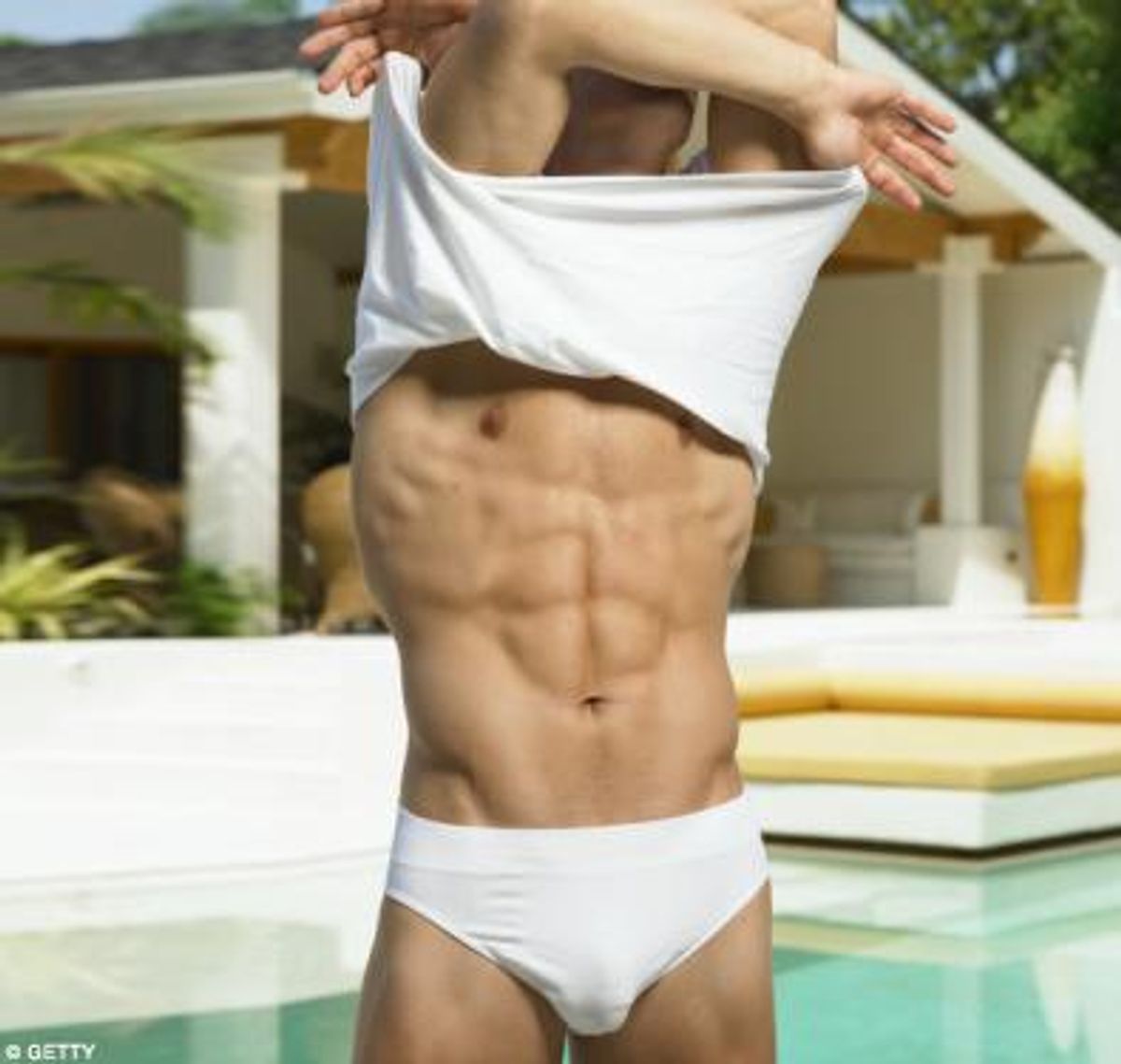CONTACTAbout UsCAREER OPPORTUNITIESADVERTISE WITH USPRIVACY POLICYPRIVACY PREFERENCESTERMS OF USELEGAL NOTICE
© 2025 Pride Publishing Inc.
All Rights reserved
All Rights reserved
By continuing to use our site, you agree to our Private Policy and Terms of Use.
PROHIBITED' the wearing of skintight form-fitting or bikini-type apparel or bathing suits by males over 12 yrs. age
If the stern, killjoy rubric of this warning sign, erected in the 1960s by the good people of Cape May, N.J., sounds like a way to rain on a gay beach party, that's because it was.
Cape May, a resort town a few hours south of New York City by car, had become a popular gay haunt by the late 1950s, nicknamed 'Cape Gay' by the cognoscenti. According to a 1969 article in Philadelphia magazine, 'their public displays of affection, particularly among men wearing women's bathing suits on the main beach'turned off the townsfolk.' The city council, eager to protect its flock from glimpsing the terrifying outline of adult male genitalia, was moved to pass a law forbidding bikini bathing suits on males over age 12'a 'phalliban,' if you will.
Now, of course, such a sign is inconceivable. Or rather'unnecessary. After all, everyone knows that male bikinis'or, to give them their trade name'turned'generic moniker, 'Speedos''are unofficially banned from all main beaches in the United States, whatever your age.
You may think them practical and sexy and iconic. You may consider them the single most perfect and pithy item of clothing ever designed for the male body. You may consider them the only thing to wear on the beach. You might even consider yourself slightly overdressed in them. But if you do, it's probably because you're gay. Or foreign. Speedos, otherwise known as 'banana hammocks,' 'marble bags,' 'noodle benders,' and 'budgie smugglers,' are apparently as un-American as Borat's body thong.
Speedos on a nongay beach are the surest way to earn yourself angry stares, abuse, and plenty of room for your beach towel. As a result, Speedos have in the United States become a badge of gay pride and exclusion'as overt homophobia declines, rampantly overt Speedophobia is bringing U.S. gays and Brazilians together, huddling together at the far end of the beach in their Lycra.
Male celebs like David Beckham, Cristiano Ronaldo, and Daniel Craig may now be nicely filling out their Speedos on their beach holidays'but none of these fellows are American. Speedos and even more revealing male swimsuits are popular in South America, Asia, much of Europe, and especially, of course, in the land of the pert-butted lifesaver: Australia, the place where the 'Aussie cossie' and much of the beach lifestyle we know today was born.
The Speedo is more than just 'gay' beachwear: It's a symbol of sexual freedom and a rediscovery of the body after centuries of clammy Christian morality.
Bathing and swimming are undoubtedly pagan passions. The ancients invented the seaside resort and spent a great deal of gold on, and time in, their blessed public baths, where the men bathed and swam naked. Not because they were indifferent to nakedness, but because they esteemed virility. Every night was wet jockstrap night (without the jockstrap) at the Roman baths, and especially well-endowed bathers were likely to be greeted with a round of applause; during the reign of notorious size queen Emperor Elagabalus, those who hung low at the baths were promoted to high office.
Alas, neither swimming nor bathing nor size-queenery survived the decline of the Roman Empire. Medieval Christianity, with its ghastly suspicion of the body, rendered water'the sensual cleanser of limbs 'suspect. As late as the 16th century, bathing was thought to be wicked, unhealthy, and, er, filthy. (Even Catholic baptism used only 'holy' water, water that had been blessed, symbolizing the cleansing blood of Christ: Sin was the deep-down dirt that Christianity was angry with.)
The English were the first to rediscover the lost art of swimming, largely as a result of their exploration of Polynesia in the 18th century, where swimming was common amongst the blissfully naked natives. By the 19th century swimming in rivers, lakes, and the sea was almost as popular in England as it had been in Rome'frequently naked, males and females, sometimes at the same time.
Christian moralists, their influence having resurged in the late 19th century, were naturally incandescent at these displays of wanton happiness. They successfully campaigned for local bylaws banning daylight bathing, or insisting on the use of 'bathing machines' that allowed the bather to enter and depart the water unseen, or requiring 'neck-to-knee' bathing costumes (New York State had such a law until as late as 1938). A typical swimming costume comprised a pair of woolen knickers extending to the knees and a sleeveless jersey. Not a good look.
To their eternal credit, it was the Australians who struck the first blow against the 19th-century phalliban. With typical Aussie obstinacy, the men of Manly Beach chose simply to disregard the pissy-prissy laws banning daytime bathing. Faced with this seaside insurrection, local authorities threw in the towel and lifted the ban in 1903. The rest of Australia followed (swim)suit, though precisely what kind of swimsuit was still contested. Many male bathers disregarded the neck-to-knee ordinances, either rolling their one-piece down to the waist or, wearing trunks, simply improvising. Good Christian folk found this intolerable. There was a strident campaign by decent, upstanding, if slightly pallid, Christians to get male bathers to wear modesty-preserving bathing 'tunics.' Protests by angry crowds of male bathers at Manly and Bondi Beach'wearing ballet skirts and sarongs'put an end to the phalliban.
So it was in Australia, a warm country where most of the population tenderly hug the coastline and pay little attention to busybodies (perhaps because Australia began as a convict colony), that the bodily freedom of the modern beach lifestyle ('surfers rather than serfs!') was invented, anticipating by decades the sexual revolution of the 1960s'giving men's packets and asses freedom of expression. It was this, not Kylie Minogue, that was their greatest contribution to world culture. Australia, a country fond of casually abbreviating English, abbreviated the male bathing 'cossie,' and with it Victorian morality.
The institution that did more to export this vision of a sandy, nicely rounded utopia than any other, smuggling millions upon millions of 'budgies,' was originally called MacRae Knitting Mills after the family who founded it in Australia in 1914. Among the first companies to produce specifically 'athletic' designs (i.e., swimming costumes that didn't double as sea anchors), MacRae changed its name to 'Speedo' in 1928 after staff member Captain Parsons coined the slogan 'Speed on in your Speedos.'
In 1955, Speedo introduced nylon into its fabric for competitive swimwear (unwittingly inventing a whole new branch of fetishism). The 1956 Melbourne Olympics provided a sensational debut for the new sheer style of brief briefs when Speedo sponsored the medal-sweeping Australian team. By the time of the 1968 Olympics and through the '76 games, almost every gold medalist swimmer wore Speedos. Naturally, men all over the globe wanted to enjoy the sensation for themselves.
Even in the United States. Up until the early 1980s, Speedos were a common sight here, both on the beach and at the pool. Everything was lovely and snug and nicely outlined. But then something horrifying happened. Sometime in the late '80s men's swimsuits began to grow in length and bulk. Year by year they crept down the thigh toward the knee'and beyond'all the while billowing clownishly outward. Now U.S. men wear, of their own volition, not even the knee-length woolen knickers that the Australian men of Manly heroically protested in the early 20th century, but bloomers, a voluminous form of female attire last seen in the 1850s (and generally regarded as ridiculous back then). In the water, today's Speedophobic males are half-man, half-jellyfish.
Unfittingly enough, this tragic trend began with someone wearing two pairs of shorts at the same time. In the '70s basketball shorts were skimpy (almost like Oz football shorts), but Michael Jordan popularized sexless long shorts in the NBA in the late 1980s. 'He wanted to keep wearing his lucky [University of] North Carolina shorts under his Chicago Bulls shorts,' explains Australian academic David Coad, author of an upcoming book on sexuality, gender, and sport, 'and decided to wear a longer pair to cover the shorter ones.' Because Jordan was Jordan, others copied, and thus baggy shorts became fashionable. It seems that this evil trend spread to male swimwear.
There was, I'd venture, another, weightier reason for this swimwear elephantiasis. The late '80s was also when male obesity became a big trend in the United States. Baggy shorts hide baggy buttocks. They also wear higher, and their large profile makes a baggy stomach considerably less obvious than when hanging over the waistband of a Speedo. Moreover, 'board shorts' hide the chicken legs of a car-centered society in which men watch sport (while eating) instead of playing. Is it simply a coincidence that when many young American men saw their bodies losing masculine definition they started wearing ladies' bloomers?
The '80s also saw the rise of the male as appetizing, idealized media sex object. The bar for male beauty was being set higher and higher as the reality was getting heavier and heavier. The tyranny of 'boardies' is an expression of male self-consciousness, self-loathing'and paranoia both of being 'checked out' and not measuring up. The '80s saw a steep rise in the American male's awareness of gays'and with it his desire not to be mistaken for one by in any way signaling that he had an ass and a packet. Baggy shorts are a deliberate and cruel affront to homos'but it's nice to know that straight men are thinking about us so much.
Gays are, of course, flamboyant Speedophiles. They are less likely to be overweight. They are more likely to be worked-out. Hence their wearing Speedos really rubs people's noses in it'in every sense. Gays are more than happy to advertise the highly versatile sex-object status of the male body'and a Speedo screams Cock! Balls! Ass!'in any order or combination you fancy.
It's as obvious as a badly smuggled budgie that despite the pagan passions of pop culture and an enthusiastic uptake of the beach lifestyle, the promise of sandy sexual liberation has come slightly adrift stateside. The painfully unequal sexual division of labor on U.S. beaches, where women wear little more than eyeliner and men wear tents'without the pole'is a sorry testament to that.
The phalliban spirit of 1960s Cape May has triumphed.
From our Sponsors
Most Popular
39 LGBTQ+ celebs you can follow on OnlyFans
November 19 2024 9:39 AM
27 LGBTQ+ reality dating shows & where to watch them
March 24 2025 11:32 AM
21 times male celebrities had to come out as straight
November 19 2024 3:33 PM
17 queens who quit or retired from drag after 'RuPaul's Drag Race'
November 30 2024 12:26 AM
Love is in the air! Unforgettable gay kissing scenes from TV & movies
February 12 2025 3:07 AM
48 steamy celebrity Calvin Klein ads the gays won't forget
March 17 2025 5:42 PM
Murray Bartlett's 8 best gay roles in TV shows & movies
February 12 2025 2:33 PM
29 out & proud LGBTQ+ country artists you should be listening to
April 15 2025 3:21 PM
Ranking the highest-earning queens in 'RuPaul's Drag Race' herstory
October 25 2024 4:04 PM
All the 'Drag Race' queens on OnlyFans (& what they're showing)
March 21 2025 10:57 AM
Latest Stories
Media mogul Carlos King teases potential Bravo return and 'his type of man'
April 21 2025 4:46 PM
Senate staffer in Capitol Hill sex video recounts backlash
April 21 2025 3:22 PM
Video: Nancy Mace drops F-bomb on Ulta man in tight shorts
April 21 2025 1:00 PM
'Sinners' review: Ryan Coogler reinvents sexy vampires in 2025's best blockbuster so far
April 21 2025 6:24 PM
Best lesbian films from each of the last 20 years of sapphic cinema
April 21 2025 3:56 PM




















































































